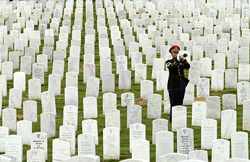Memorial Day 2010

HEADQUARTERS GRAND ARMY OF THE REPUBLIC
General Orders No.11, WASHINGTON, D.C., May 5, 1868
I. The 30th day of May, 1868, is designated for the purpose of strewing with flowers or otherwise decorating the graves of comrades who died in defense of their country during the late rebellion, and whose bodies now lie in almost every city, village, and hamlet church-yard in the land. In this observance no form of ceremony is prescribed, but posts and comrades will in their own way arrange such fitting services and testimonials of respect as circumstances may permit.
We are organized, comrades, as our regulations tell us, for the purpose among other things, "of preserving and strengthening those kind and fraternal feelings which have bound together the soldiers, sailors, and marines who united to suppress the late rebellion." What can aid more to assure this result than cherishing tenderly the memory of our heroic dead, who made their breasts a barricade between our country and its foes? Their soldier lives were the reveille of freedom to a race in chains, and their deaths the tattoo of rebellious tyranny in arms. We should guard their graves with sacred vigilance. All that the consecrated wealth and taste of the nation can add to their adornment and security is but a fitting tribute to the memory of her slain defenders. Let no wanton foot tread rudely on such hallowed grounds. Let pleasant paths invite the coming and going of reverent visitors and fond mourners. Let no vandalism of avarice or neglect, no ravages of time testify to the present or to the coming generations that we have forgotten as a people the cost of a free and undivided republic.
If our eyes grow dull, other hands slack, and other hearts cold in the solemn trust, ours shall keep it well as long as the light and warmth of life remain to us.
Let us, then, at the time appointed gather around their sacred remains and garland the passionless mounds above them with the choicest flowers of spring-time; let us raise above them the dear old flag they saved from dishonor; let us in this solemn presence renew our pledges to aid and assist those whom they have left among us a sacred charge upon a nation's gratitude, the soldier's and sailor's widow and orphan.
II. It is the purpose of the Commander-in-Chief to inaugurate this observance with the hope that it will be kept up from year to year, while a survivor of the war remains to honor the memory of his departed comrades. He earnestly desires the public press to lend its friendly aid in bringing to the notice of comrades in all parts of the country in time for simultaneous compliance therewith.
III. Department commanders will use efforts to make this order effective.
By order of
JOHN A. LOGAN,
Commander-in-Chief
N.P. CHIPMAN,
Adjutant General
Official:
WM. T. COLLINS, A.A.G.
-----
On the morning of August 16, 2005, as my wife Retta and I sat with Wes and Abbey just after breaking the news to them of Mikes death earler that morning, then 13 year old Abbey buried her head into my shoulder, sobbing these words: "he was supposed to chase away my first boyfriend, he was supposed to cheer at my graduation from high school, he was supposed to be an uncle to my children..." These words seared my heart, broken as it was. I shall never forget them. She lost her oldest brother that day, her "Bubs" which she called him short for his nickname, Bubba.
General Orders No. 11 - Washington Times
20,000 Flags - Forward Movement
Remembering Mark - Kerplunk
Graduation Night: Moon Over Yusufiyah - Mudville Gazette
Four-Day Weekend - Wings Over Iraq
Coming Home - Mudville Gazette
A Way To Honor A Fallen Hero Today - Blackfive
Memorial Day - Prairie Pundit
Memorial Day: Fitting Memorials and Passing of Torches - Blackfive
National Memorial Day Parade - Blackfive
What We Remember on Memorial Day - Los Angeles Times
Remember Who? - Paragould Daily Press
Take a Moment to Reflect on Memorial Day - Chillicothe Gazette
Memorial Day Has Relevance - Odessa American
Remember Vets; Celebrate Freedoms - Bluefield Daily Telegraph
Is the Traditional Memorial Day Celebration Still Relevant? - Delmarva Daily Times
A Special Monday - Battle Creek Enquirer
Memorial Day's First Blossoms - Louisville Courier-Journal
Memorial Day About More Than Barbecues, Sales - Rio Rancho Observer
A Day to Honor, Not Celebrate - Duluth News Tribune
Don't Forget the 'Memory' in Memorial Day - New Haven Register
Memorial Day - Southeast Missourian
Honoring the Fallen - Covington News
Remember the Reason for Memorial Day - Mount Airy News
We Wish We Didn't Need Tomorrow But, Sadly, We Do - Leader Vindicator
Memorial Day Used to be May 30, Still Should Be - Milwaukee Journal Sentinel
'Yes, We Thank You. Yes, We Remember You.' - Fort Wayne Journal Gazette
Honoring the Fallen - Catskill Daily Mail
Memorial Day is Time to Reflect Upon Sacrifices - Daily Republic
A Time to Remember Their Sacrifices - Hillsboro Times Gazette
Giving Their Last Full Measure - McCook Daily Gazette
They Gave Their Lives - Casper Star-Tribune
Memorial Day is Foremost a Day of Honor - Lexington Dispatch
Every Day is Memorial Day - Washington Times
Seeing a Fallen Soldier Home - Washington Times
Maintain Peace by Staying Strong - Washington Times
The Glory of War - Washington Times
